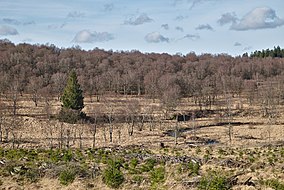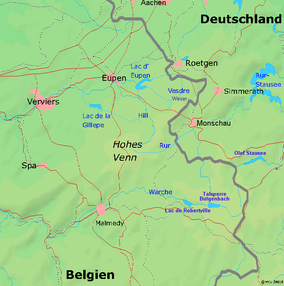
Back Hautes Fagnes AST Hohes Venn CEB Hautes Fagnes Czech Hohes Venn German Altaj Marĉoj Esperanto Hautes Fagnes Spanish Hautes Fagnes Estonian Hautes Fagnes French Hohes Venn Hungarian Hautes Fagnes Italian
| High Fens | |
|---|---|
 Fagne Tîrifaye in Waimes | |
 Map of the High Fens | |
| Location | Liège Province, in Belgium and also in nearby parts of Germany, between the Ardennes and the Eifel |
| Coordinates | 50°32′40″N 6°4′40″E / 50.54444°N 6.07778°E |
| Area | 4,501.2 ha (17.379 sq mi) |
| Established | 1957 as Nature Reserve |
| Website | [1] |
| Official name | Les Hautes Fagnes |
| Designated | 24 March 2003 |
| Reference no. | 1405[1] |
The High Fens (German: Hohes Venn; French: Hautes Fagnes; Dutch: Hoge Venen), which were declared a nature reserve in 1957, are an upland area, a plateau region in Liège Province, in the east of Belgium and adjoining parts of northwestern Germany, between the Ardennes and the Eifel highlands. The High Fens are the largest nature reserve or park in Belgium, with an area of 4,501.2 ha (11,123 acres; 45.012 km2); it lies within the German-Belgian natural park Hohes Venn-Eifel (700 km2 (270 sq mi)), in the Ardennes. Its highest point, at 694 metres (2,277 ft) above sea level, is the Signal de Botrange near Eupen, and also the highest point in Belgium. A tower 6 metres (20 ft) high was built here that reaches 700 metres (2,297 ft) above sea level.[2][3] The reserve is a rich ecological endowment of Belgium covered with alpine sphagnum raised bogs (watered only by precipitation, instead of surface water, as the appellation “fens” would imply), both on the plateau and in the valley basin; the bogs, which are over 10,000 years old, with their unique subalpine flora, fauna and microclimate, are key to the conservation work of the park.[4][5]
In 1966, the European Council awarded the "Diploma of Conservation" to the High Fens, for their ecological value.[3] In 2008, Belgium has added the High Fens to its tentative list of UNESCO World Heritage sites.
- ^ "Les Hautes Fagnes". Ramsar Sites Information Service. Retrieved 25 April 2018.
- ^ Carl McKeating; Rachel Crolla (January 2010). Europe's High Points. Cicerone Press Limited. pp. 45–. ISBN 978-1-85284-577-3. Retrieved 2 June 2011.
- ^ a b "Comment se comporter dans les réserves naturelles" (in French). Official website of Naturpark-Hohesvenn-Eifel. Retrieved 2 June 2011.
- ^ "Hautes Fagnes–Eifel Nature Park". Walkingworld.com. Walkingworld Ltd. Archived from the original on 2003-11-27. Retrieved 2 June 2011.
- ^ George McDonald (26 April 2011). Frommer's Belgium, Holland and Luxembourg. John Wiley and Sons. pp. 250–. ISBN 978-0-470-88766-0. Retrieved 2 June 2011.